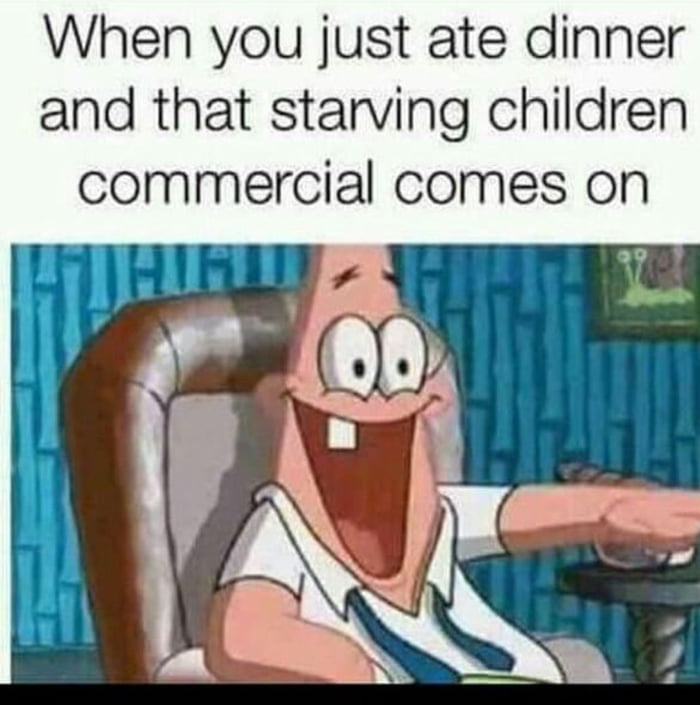
Memes of great humor to me are those that feature dark humor, the subject of the humor may vary but the crass or sometimes comically crafted delivery are what make a meme of great enjoyment to me. The first meme I chose refers to the national epidemic surrounding the frequency of school shootings; it illustrates the traditional image of throwing caps into the air after graduating but with one caveat, replacing the caps with bulletproof vests, accompanied with the caption, ‘When you finally graduate high school in the USA.’ While the underlying subject matter is of grave concern, the extremes with which this means illustrates the subject, synonymizing the significance and importance of graduation caps with bulletproof vests, highlights a sense of comical absurdness that would also be jovial if it did not hit so close to home.

The second meme I choose pokes fun at the commercials that solicit donations for hungry children, specifically, the two-minute long tropey advertisements that show nothing but skin and bone children with an overlay of somber music and a soft narration about how ‘for X amount of dollars a day, you could be a child’s savior.’ The meme features beloved children's icon Patrick Star sitting in a recliner pointing at the television with the most hyperbolic smile with the caption, ‘When you just ate dinner and that starving children commercial comes on.’ One of the most critical methods in which this meme evokes humor is the juxtaposition of a beloved children’s cartoon character doing something innocuous, such as pointing and smiling at the television, overlayed with the aforementioned caption, painting a humorous picture that still touches on the severe problem of food insecurity.

The most critical similarity between these two memes is their use of keying, as Shifman mentions, ‘keying is the tone, or modality, of the internal framing of discursive events as formed by their participants (Shifman 2013)’. The creators of these memes key their content as sardonic, capitalizing on the sharp dichotomy between a seemingly innocent image supplemented with a darker element, whether through captioning or image manipulation. Both memes benefit from the viewer having prerequisite knowledge of the content within, whether it be information about the epidemics within American public school, knowing what cartoon Patrick Star belongs to, or having previously seen one of those advertisements for starving children. Without these pieces of information, ‘the meme has no existence outside the events, practices, and texts in which it appears (Shifman 2013).’ That is, a prospective viewer will glance at these memes, not fully understand the significance, and keep scrolling, or even worse, misunderstand the significance and potentially become closed off to considering the meme on a more introspective level. ‘Memes are complex units, distinct and memorable—units with staying power (Gleick 2011).’ One of the reasons memes are so distinct and memorable is because they reflect culture, the more accurate the cultural reflection is, the more likely they are to become memorable to viewers. These memes are no exception, they just represent darker aspects of culture not often explored or as heavily shared as memes that reflect lighter and more digestible cultural aspects. As a general principle among humans, 'social norms, perceptions, and preferences are crucial in memetic selection processes (Shifman 2013). Darker memes like these which challenge preconstructed notions of what is acceptable to laugh at or enjoy as satire are one of the reasons why memes remain as notable and influential as they are today. Once again as culture shifts and evolves, so do the perceived notions of what is acceptable to make humorous content from.